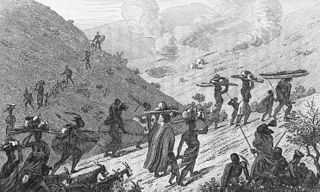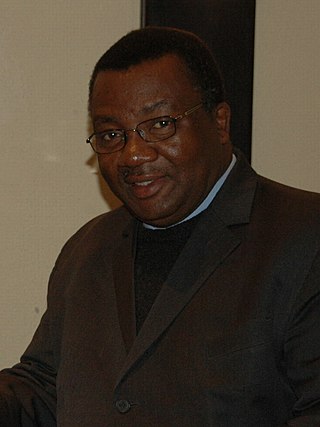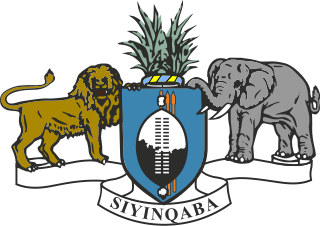Related Research Articles

Eswatini, formally the Kingdom of Eswatini and also known by its former official name Swaziland, is a landlocked country in Southern Africa. It is bordered by Mozambique to its northeast and South Africa to its north, west, south, and southeast. At no more than 200 km (120 mi) north to south and 130 km (81 mi) east to west, Eswatini is one of the smallest countries in Africa; despite this, its climate and topography are diverse, ranging from a cool and mountainous highveld to a hot and dry lowveld.

Artifacts indicating human activity dating back to the early Stone Age have been found in the Kingdom of Eswatini. The earliest known inhabitants of the region were Khoisan hunter-gatherers. Later, the population became predominantly Nguni during and after the great Bantu migrations. People speaking languages ancestral to the current Sotho and Nguni languages began settling no later than the 11th century. The country now derives its name from a later king named Mswati II. Mswati II was the greatest of the fighting kings of Eswatini, and he greatly extended the area of the country to twice its current size. The people of Eswatini largely belong to a number of clans that can be categorized as Emakhandzambili, Bemdzabu, and Emafikamuva, depending on when and how they settled in Eswatini.

The Mfecane, also known by the Sesotho names Difaqane or Lifaqane, is a historical period of heightened military conflict and migration associated with state formation and expansion in Southern Africa. The exact range of dates that comprise the Mfecane varies between sources. At its broadest, the period lasted from the late eighteenth century to the mid-nineteenth century, but scholars often focus on an intensive period from the 1810s to the 1840s. The concept first emerged in the 1830s and blamed the disruption on the actions of Shaka Zulu, who was alleged to have waged near-genocidal wars that depopulated the land and sparked a chain reaction of violence as fleeing groups sought to conquer new lands. Since the latter half of the 20th century, this interpretation has fallen out of favor among scholars due to a lack of historical evidence.

Absalom Themba Dlamini was the Prime Minister of Eswatini from November 2003 to September 2008. He is the managing director of Tibiyo Taka Ngwane.

The Swazi or Swati are a Bantu ethnic group native to Southern Africa, inhabiting Eswatini, a sovereign kingdom in Southern Africa, and South Africa's Mpumalanga province. EmaSwati are part of the Nguni-language speaking peoples whose origins can be traced through archaeology to East Africa where similar traditions, beliefs and cultural practices are found.

Sobhuza II, was Ngwenyama (King) of Swaziland for 82 years and 254 days, the longest verifiable reign of any monarch in recorded history.
Ngwane V was the King of Swaziland from 1895 until his death on 10 December 1899. Ngwane was born the son of Mbandzeni and his mother was Labotsibeni Mdluli. He ascended to the throne after a short regency of Queen Mother Tibati Nkambule. He was only 16 years old when he became king. His royal capital was at Zombodze while the Queen Mother's residence was at Lobamba. Ngwane became the king after the Swaziland convention of 1894. This had led to the classification of Swaziland as a protected state of the South African Republic which was then led by President Paul Kruger. During this time Swaziland had a partial Dutch administration in parallel to Ngwane's administration. The Dutch or European for European interests and Ngwane as head and authority of the Swazi nation. An annual payment was made to Ngwane and Labotsibeni while they were in office from taxes collected and from contributions from concessionaires and taxes. Ngwane's rule was short. In 1899 the Anglo-Boer war began, and brought to an end the Dutch or Boer partial administration of Swaziland and hence gave way to independence. However Mahlokohla died on 10 December of that year while dancing incwala. This was hid from the nation until the ceremony was over. Ngwane was succeeded by his four-month-old son Nkhotfotjeni and his wife Lomawa Ndwandwe. His mother Labotsibeni who had been very influential during his reign continued as queen regent until Sobhuza was crowned in 1921. Ngwane's reign gave way to a stable territory surrounded by conflicting states. Today Mahlokohla is named for one of the main streets, Mahlokohla Street in Swaziland's capital Mbabane.
King Mswati II, also known as Mswati and Mavuso III, was the king of Eswatini between 1840 and 1868. He was also the eponym of Eswatini. Mswati is considered to be one of the greatest fighting kings of Eswatini.

KaNgwane was a bantustan in South Africa, intended by the apartheid government to be a semi-independent homeland for the Swazi people. It was called the "Swazi Territorial Authority" from 1976 to 1977. In September 1977 it was renamed KaNgwane and received a legislative assembly. After a temporary suspension of its homeland status during 1982, the legislative assembly was restored in December 1982. KaNgwane was granted nominal self-rule in August 1984. Its capital was at Louieville. It was the least populous of the ten homelands, with an estimated 183,000 inhabitants. Unlike the other homelands in South Africa, KaNgwane did not adopt a distinctive flag of its own but flew the national flag of South Africa.
Sobhuza I (1788–1850) was king of Eswatini, from 1815 to 1850. Born around the year 1788, his father was King Ndvungunye, and his mother was Somnjalose Simelane. He was called Somhlolo, meaning "Mysterious man", upon his birth because his father, Ndvungunye, was struck by lightning. When Sobhuza was king, Lojiba Simelane, instead of his mother, Somnjalose was Queen Mother because Somnjalose was an inhlanti or support bride to Lojiba. Somhlolo is a greatly revered king of Eswatini. He had his first royal capital or kraal at Zombodze in the Shiselweni region, but moved it north to new Zombodze in central Eswatini. Swazis celebrate Somhlolo Day every September 6 as their Independence Day and the national stadium is named Somhlolo stadium. Sobhuza was succeeded by his son Mswati II and his wife Tsandzile Ndwandwe as Queen Mother after a short regency by Queen Lojiba Simelane. Sobhuza by the time of his death had conquered a country claimed to reach to modern day Barberton in the north, Carolina in the west, Pongola River in the south and Lubombo Mountains in the east.
Lobamba is a city in Eswatini, and is one of the two capitals, serving as the legislative, traditional, spiritual, seat of government of the Parliament of Eswatini, and Ludzidzini Royal Village, the residence of Queen Ntfombi, the Queen Mother.
Soshangana Ka Gasa Zikode, born Soshangana Nxumalo, was the Founder and the Monarch of the Gaza Empire, which at the height of its power stretched from the Limpopo river in southern Mozambique up to the Zambezi river in the north. Soshangana ruled over the Gaza state from 1825 until his death in 1858. Soshangana was also known by the name of Manukosi.
Mbandzeni was the King of Swaziland from 1872 until 1889. Ingwenyama Mbandzeni was the son of Mswati II and Nandzi Nkambule. His mother the wife of King Mswati had died when he was still very young. Mbandzeni ascended to the throne after his half brother Ludvonga II died before he could become the king. Ludvonga's death resulted in his mother Inkhosikati Lamgangeni adopting Mbandzeni who was motherless as her son, thus making him king and her the queen mother of Swaziland. His royal capital was at Mbekelweni. During his kingship Mbandzeni granted many mining, farming, trading and administrative concessions to white settlers from Britain and the Transvaal. The Boers had tricked the king into signing permanent land concesions. The king could not read or write, so the Boers made him sign the concessions with a cross. The king was told that these were not permanent land concessions but the papers themselves stated otherwise. These concessions granted with the help of Offy Sherpstone eventually led to the conventions of 1884 and 1894, which reduced the overall borders of Swaziland and later made Swaziland a protectorate of the South African Republic. During a period of concessions preceded by famine around 1877 some of the tindvunas (governors) from within Swaziland like Mshiza Maseko and Ntengu kaGama Mbokane were given permission by King Mbandzeni to relocate to farms towards the Komati River and Lubombo regions, Mshiza Maseko later settled in a place called eLuvalweni towards Nkomati River, where he was later buried. Mbandzeni, still in command of a large Swazi army of more than 15,000 men aided the British in defeating Sekhukhune in 1879 and preventing Zulu incursion into the Transvaal during the same year. As a result, he guaranteed his country's independence and international recognition despite the Scramble for Africa which was taking place at the time. Mbandzeni died after an illness in 1889 and is quoted to have said in his deathbed "the Swazi kingship dies with me". He was buried at the royal cemetery at Mbilaneni alongside his father and grandfather Sobhuza I. Mbandzeni was succeeded by his young son Mahlokohla and his wife Queen Labotsibeni Mdluli after a 5 year regency of Queen Tibati Nkambule. Today a number of buildings and roads in Swaziland are named after Mbandzeni. Among these the Mbandzeni house in Mbabane and the Mbandzeni Highway to Siteki are named after him.

The House of Dlamini is the royal house of the Kingdom of Eswatini. Mswati III, as king and Ngwenyama of Eswatini, is the current head of the house of Dlamini. Swazi kings up to the present day are referred to as Ingwenyama and they rule together with the Queen Mother who is called Indlovukati. The Swazi kings, like other Nguni nations, practice polygamy and thus have many wives and children.
Ngwane III was King of kaNgwane from 1745 to 1780. He is considered to be the first King of modern Eswatini. For his name the people were called bakaNgwane and the country was called kaNgwane or lakaNgwane. Ngwane was the son of Dlamini III and Queen LaYaka Ndwandwe. Dlamini was succeeded by Ngwane III his son with Queen LaYaka Ndwandwe. He took over the Dlamini chieftaincy and established settlements south of the Pongola River, later moving them to the north of the river banks. This makes Ngwane and his followers the founders of modern Swaziland. Ngwane ruled his Kingdom from the south east of Swaziland in the present Shiselweni district and his headquarters were called Zombodze at the foot of the Mhlosheni hills. It was at Zombodze that the Nguni ceremony incwala was celebrated for the first time.
Dlamini is an African clan and surname, common in South Africa and Eswatini. It is the most common surname in South Africa. Most people whose surname is Dlamini are also members of the Dlamini clan.
Ndvungunye was King of Swaziland from 1780 until his death in 1815 after succeeding his father, King Ngwane III following a very brief regency of Ndlovukati LaYaka Ndwandwe. Very little has been recorded of the quality of leadership under his reign. Ndvungunye built his residence or Sigodlo near Mhlosheni on feet of the eMhlosheni hills in Shiselweni, the south east of modern Swaziland near Zombodze, where his father Ngwane had settled during his reign. His rule thus indicated a period of limited expansion and consolidation which is overshadowed by that of his son King Sobhuza I. The NShiselweni settlements established under his reign which he placed under the guardianship of his chief Sukumbili Mbokane would not however provide a solid foundation for the future Swazi state as indicated by attacks after his death on Sobhuza by Ndwandwe chiefs. Ndvungunye died around 1815 after being struck by lightning. Ndvungunye was married to Lojiba Simelane and Somnjalose Simelane. It was with the latter that he had his son Sobhuza I. Lojiba however became Queen mother as she was a senior sister to Somnjalose. Sobhuza I became the king in 1815 after the regency of Queen Lomvula Mndzebele.
laNgolotsheni (Lomawa) Ndwandwe was the Ndlovukati of Swaziland, the wife of King Ngwane V, and the mother of King Sobhuza II.
Nukwase Ndwandwe was the Queen Mother of Swaziland, aunt of Sobhuza II, and the sister of Lomawa Ndwandwe.
References
- 1 2 3 Bonner, Philip (2002). Kings, Commoners and Concessionaires: The Evolution and Dissolution of the Nineteenth-Century Swazi State. Cambridge: University Press. pp. 9–27. ISBN 978-0-521-52300-4.
- 1 2 Gillis, D. Hugh (1999). The Kingdom of Swaziland: Studies in Political History. Greenwood Publishing Group. p. 14. ISBN 978-0-313-30670-9.